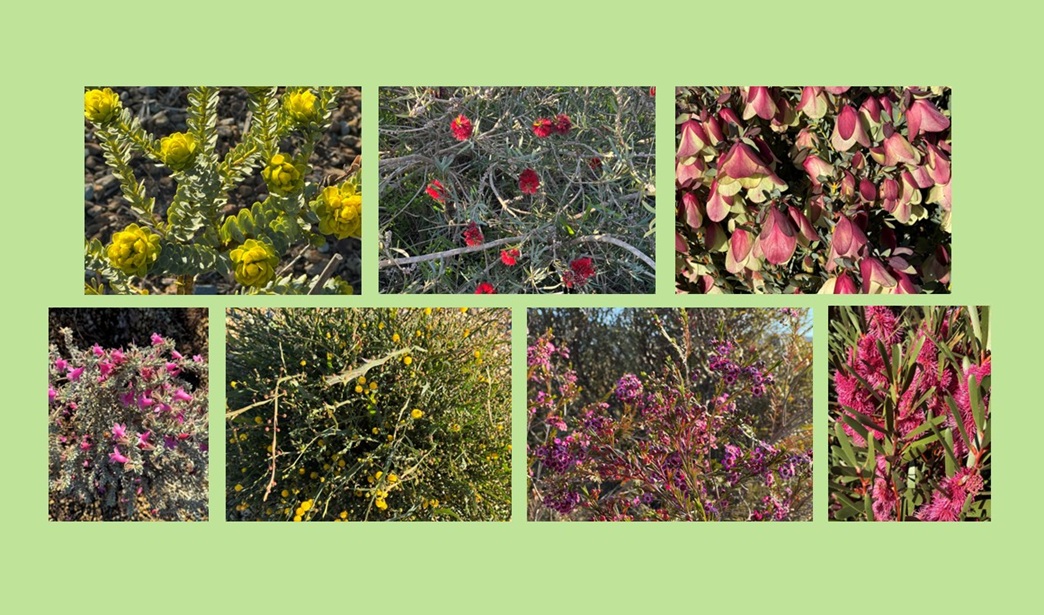Diane Beddison
“Spring is nature’s way of saying, ‘Let’s party!’” – Robin Williams
In spring anything seems possible. Spring is an exciting time as dormant plants awaken, evergreen plants put on new growth and flower and scent welcome us into the garden. It is also a busy time for gardeners. Putting in the work now while the weather is mild and the soil is moist, will provide a splendid spring display and set up your garden up for the heat of summer and the autumn beyond.
Plants of the Season
Many Australian natives flower during spring and may continue flowering during summer as well. I have been travelling lately and was able to call in at Vaughans Native Plant nursery. They graft beautiful Western Australian plants. Grafting extends the number of native plants we can grow successfully in Victorian gardens. See a collection of these plants above. Some like the Pimelea physodes (Qualup Bells) in the top right have very large flowers.
Gardening Fun
Spring activities set up our garden for summer. Plants are starting to move, so it’s time to fill in any gaps in your garden. If you or a friend have an established garden, now is the time to divide perennials plants and take softwood cuttings. With a little work you can have abundant planting at low cost.
Propagating Plants
Plants that can be divided include perennial daisies (particularly asters), sedums such as Sedum ‘Autumn Joy’, catmint, hellebores, achillea, ajuga, dichondra, violets plus the native violet, Bergenia, and Lambs ears. Some herbs and edible perennials such as Rhubarb can be readily split into several plants.
For gardeners who like an easy life, layering of perennials is perfect. Create a new Thyme plant by pinning down a healthy sprig to the soil and holding it in place, cover with a little soil. When roots have formed, cut the section off from the original plant. Leave it a little longer just to make sure it is ready. Then pot up your clone. Don’t try this with grafted plants.
Softwood is the new sappy growth. Select a healthy plant and cut off new growth from the end of a branch making sure it has several leaf nodes. Prepare the cutting by trimming off the lower and outer leaves and dipping the ends into rooting hormone. Make a hole with a dibber or pencil in a pot of well-draining potting mix. Plant cutting with 2 or 3 nodes under the soil.
Pruning
Prune hedges once the frost has gone, to have them looking thick over spring and summer.
Perennials such as herbaceous salvia, which flowers twice, should be lightly pruned in December. Australian native shrubs can also be pruned in early spring to create a lovely bushy shape for the months ahead.
Weeding
You need to keep on top of the weeds which are emerging now. Weeds take nutrients from the soil and can smoother other plants. Pull out annual weeds and pour boiling water over path weeds. Annual weeds that haven’t seeded can be dropped on the garden and allowed to rot down. Spray bulbous weeds such as Oxalis with an organic herbicide when there is no wind.
Feeding
Whilst conditions are good, hungry plants such as roses can be feed every few weeks. Feed your roses twice with a specialist rose fertiliser and other times with your favourite organic fertiliser. Australian natives require a specific native fertiliser which is low in Phosphorous.
Remove weeds from your lawn. Then aerate it using a garden fork to create holes. For a large lawn, hire a powered core aerator to remove plugs of lawn. Then feed with a fertiliser suitable for your lawn grass. Buffalo grasses prefer a slow-release fertiliser which is high in iron to look their best.
Planting
Early spring is a good time to move exotic perennials and small shrubs. Perhaps you need to purchase plants to fill some gaps or to renovate your garden. Hepburn shire is blessed with several specialist nurseries, growers of indigenous plants, as well as some general nurseries. Have fun visiting local growers and experiment with some plants you haven’t grown before.
Mulching
I prefer organic mulch because it improves soil texture and provides nutrients to the plants. Choose a coarse well-rotted mulch. For extra nutrients, sprinkle some manure on the garden before mulching. To supply even more nutrients for a vegetable garden or a new garden, lay pea straw or Lucerne hay across the garden. Because organic mulches break down, they must be regularly topped up. If your fire risk is high, apply a gravel mulch near your house.
Diane Beddison is a frequent visitor to Daylesford and the Principal of Beddison Garden Designs.





